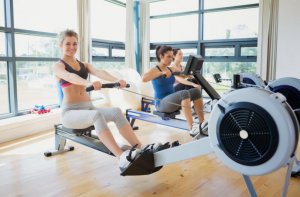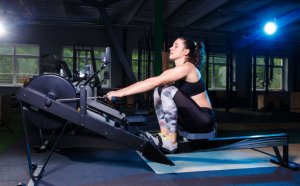The Ever Forgotten Rowing Machine
Training with the rowing machine will help you improve your general physical condition. What’s more, you will see an improvement in your performance.

You already want to improve your resistance or strength; lose weight or gain muscle. Whatever your goals, there is a piece of equipment in the gym that will meet your requirements. Besides, surely, you have not forgotten the rowing machine?
The versatility of this machine will allow you to use a variety of your muscles, which combined with a proper diet will keep you slim, strong and in good shape.
At present, there are many people who workout with the rowing machine. Thanks to the fact that this is a cardiovascular exercise to combine strength and endurance. It provides us with many benefits of traditional rowing.
In the beginning, this exercise was designed for competition rowers. Nevertheless, little by little, it gained multiple users who have never practiced outdoor rowing.
As an added benefit, we recommend this type of exercise for everyone. More importantly, it is always advisable to consult with your doctor when you are going to do a physical activity that requires a significant effort.

Basic technique of the rowing machine
Much like swimming, with rowing (where we use most of the muscles in our body), it is essential to pay attention to the technique.
It is better to start with the basics and work from a solid base. Do not focus on the deeper part or leave the technique aside.
Ensure that the straps are securely fastened around your feet, and are in the correct position. Place the straps so the pushing force comes from the tip of your feet, as in cycling.
When you hold the handle of the bar, initially, your knees should be slightly flexed. Your arms are extended in front of your torso.
From this position, and ensure you keep your back straight, we push first with the legs, before pulling with both the back and the arms to allow the legs reach their full extension.
Throughout the ‘race’, it is important to keep your back straight and do not pivot too far backwards or forwards.
Be certain to pay special attention to the following points:
- Make sure your elbows stay close to your body
- Make sure the pelvis and the back advance at the same time
- Keep the back completely straight, without rounding on the shoulders
- Slight inclination forwards and backwards is allowed
- The force must come, almost entirely, from our legs
- Try to do the whole exercise with a fluid movement

How to workout with the rowing machine
Next, we present a series of exercises that you can perform with your rowing machine. These will be useful to incorporate into your workout routine. They will work your back, core and arms.
Exercise your back on the rowing machine
This is an ideal movement to work your lower back. We start from a position where we hold the bar with prone grip.
We maintain the prone grip and progress quickly towards a medium grip that will allow you to work the muscles located in the middle area of the back. As an alternative, you can switch to a medium grip that will activate the muscles of the upper back and shoulders.
Moreover, this exercise is so simple and it will help you to improve posture.
Exercise on the rowing machine to activate the core
Remember, keep the core and the upper part of the body immobile, so that we let the lower part of our body do the work. Pull towards yourself, again and again in a sweeping motion with prone grip, maintaining a straight back.
Exercise on a single-arm rowing machine
Holding the bar between our ring and heart fingers, without rotation and with the core acting as a stabilizer, pull the bar backwards.
If you want to generate a greater intensity you can incorporate the rotation to the same side of the arm.
Training with the rowing machine will help you improve your general physical condition. What’s more, you will see an improvement in your performance.

You already want to improve your resistance or strength; lose weight or gain muscle. Whatever your goals, there is a piece of equipment in the gym that will meet your requirements. Besides, surely, you have not forgotten the rowing machine?
The versatility of this machine will allow you to use a variety of your muscles, which combined with a proper diet will keep you slim, strong and in good shape.
At present, there are many people who workout with the rowing machine. Thanks to the fact that this is a cardiovascular exercise to combine strength and endurance. It provides us with many benefits of traditional rowing.
In the beginning, this exercise was designed for competition rowers. Nevertheless, little by little, it gained multiple users who have never practiced outdoor rowing.
As an added benefit, we recommend this type of exercise for everyone. More importantly, it is always advisable to consult with your doctor when you are going to do a physical activity that requires a significant effort.

Basic technique of the rowing machine
Much like swimming, with rowing (where we use most of the muscles in our body), it is essential to pay attention to the technique.
It is better to start with the basics and work from a solid base. Do not focus on the deeper part or leave the technique aside.
Ensure that the straps are securely fastened around your feet, and are in the correct position. Place the straps so the pushing force comes from the tip of your feet, as in cycling.
When you hold the handle of the bar, initially, your knees should be slightly flexed. Your arms are extended in front of your torso.
From this position, and ensure you keep your back straight, we push first with the legs, before pulling with both the back and the arms to allow the legs reach their full extension.
Throughout the ‘race’, it is important to keep your back straight and do not pivot too far backwards or forwards.
Be certain to pay special attention to the following points:
- Make sure your elbows stay close to your body
- Make sure the pelvis and the back advance at the same time
- Keep the back completely straight, without rounding on the shoulders
- Slight inclination forwards and backwards is allowed
- The force must come, almost entirely, from our legs
- Try to do the whole exercise with a fluid movement

How to workout with the rowing machine
Next, we present a series of exercises that you can perform with your rowing machine. These will be useful to incorporate into your workout routine. They will work your back, core and arms.
Exercise your back on the rowing machine
This is an ideal movement to work your lower back. We start from a position where we hold the bar with prone grip.
We maintain the prone grip and progress quickly towards a medium grip that will allow you to work the muscles located in the middle area of the back. As an alternative, you can switch to a medium grip that will activate the muscles of the upper back and shoulders.
Moreover, this exercise is so simple and it will help you to improve posture.
Exercise on the rowing machine to activate the core
Remember, keep the core and the upper part of the body immobile, so that we let the lower part of our body do the work. Pull towards yourself, again and again in a sweeping motion with prone grip, maintaining a straight back.
Exercise on a single-arm rowing machine
Holding the bar between our ring and heart fingers, without rotation and with the core acting as a stabilizer, pull the bar backwards.
If you want to generate a greater intensity you can incorporate the rotation to the same side of the arm.
All cited sources were thoroughly reviewed by our team to ensure their quality, reliability, currency, and validity. The bibliography of this article was considered reliable and of academic or scientific accuracy.
- Faelli E, Panascì M, Ferrando V, Codella R, Bisio A, Ruggeri P. High-Intensity Interval Training for Rowing: Acute Responses in National-Level Adolescent Males. Int J Environ Res Public Health. 2022 Jul 2;19(13):8132.
- Ingham SA, Carter H, Whyte GP, Doust JH. Physiological and performance effects of low- versus mixed-intensity rowing training. Med Sci Sports Exerc. 2008 Mar;40(3):579-84.
- Kang SR, Yu CH, Han KS, Kwon TK. Comparative analysis of basal physical fitness and muscle function in relation to muscle balance pattern using rowing machines. Biomed Mater Eng. 2014;24(6):2425-35.
- Volianitis S, Yoshiga CC, Secher NH. The physiology of rowing with perspective on training and health. Eur J Appl Physiol. 2020 Sep;120(9):1943-1963.
This text is provided for informational purposes only and does not replace consultation with a professional. If in doubt, consult your specialist.








